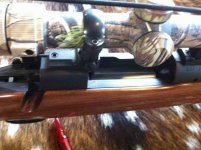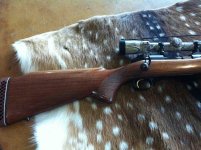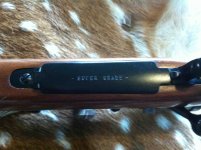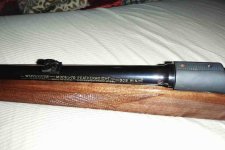Some history on the pre-'64 Model 70
I thought you might enjoy some history I uncovered on the "pre-1964" Winchester Model 70.
John
It was called "the rifleman's rifle." The pre-1964 Winchester Model 70 has long been noted by many experts as perhaps the best bolt action hunting rifle ever made. Its predecessor was the Model 54, which was produced from 1925 to 1936. This was a fine bolt action rifle, but the bolt, safety and stock were not designed for the use of telescopic sights.
The much-improved prototype Model 70s were first produced in 1935. Nineteen rifles were manufactured in that year, but none left the factory. In 1936, the first production guns were warehoused (through serial number 2,238). In 1937, these were cataloged and sales began. The Model 70 continued many of the features of the Model 54 including the 1903 Springfield-type coned barrel breech, the dual front locking lugs, the receiver-mounted ejector, and the Mauser-style non-rotating extractor which gave controlled cartridge feeding. A gas port was placed on the right side of the receiver ring, allowing gas from a possible punctured primer to escape without being directed to the shooter's face. The military-type wing safety of the Model 54 was scrapped and replaced with a bolt-sleeve safety working in the horizontal plane, allowing mounting of scope sights. The stamped one-piece trigger guard/floorplate of the preceding rifle was abandoned for one with a milled trigger guard and a hinged floorplate incorporating a plunger release. The bolt sleeve was re-contoured to a more attractive contour. While the Model 54 had a trigger-actuated bolt release, the Model 70 had a receiver-mounted bolt stop separate from the trigger. Finally, the new trigger mechanism, which was no longer encumbered by also being a bolt stop, was simple and easily adjustable by the user for weight of pull and for overtravel.
From 1937 until 1964, the Model 70 went through a number of cosmetic and mechanical changes. The original thumbpiece safety (which entered the field of vision when in the safe position) was modified with a transitional and later perfected thumbpiece. These latter two safeties operated on the right side of the bolt sleeve and operated silently with three positions – fire, safe with bolt manipulation possible, and safe with a locked bolt. This arrangement has been widely copied on custom and prestige rifles today. The shape of the receiver tang was altered from a cloverleaf to an elliptical configuration in later production to lessen the chance of a split stock in that area. Early and transition guns had an enlarged-diameter section on the barrel which mounted the rear sight and accepted a forward (third) stock screw.
Pre-World War II rifles (up to early 1942) have serial numbers from 1 to about 60,500. The bolt shrouds on these will be flat on top rather than round, and the bolt handle will have a 90-degree step at the base. Pre-war rifles will all have charger clip slots in the front of the rear receiver bridge. Later (transition) guns had these only by special order or on the target rifles in .30-06 only. These early guns will not be drilled and tapped on top of the receiver for scope mounts. However, they will have two drilled and tapped holes on the left side of the receiver for peep sights; early scope mounts also utilized these holes for scope mounting.
"Transition" guns were made from 1945 until 1951. Serial numbers ranged from 60,500 to 87,000 on the standard actions, and from 63,200 to 121,700 for magnum actions. Apparently two assembly lines were used for these two different actions. The safety was changed so it was swung to the muzzle to fire. These rifles have two scope mounting holes on the rear bridge, and the top of the receiver had no recessed wavy lines as did later production. The rifle illustrated is a standard transitional rifle in caliber .30-06, manufactured in 1949. As a point of information, most rifles have the year of manufacture stamped on the bottom of the barrel just in front of the receiver.
Final pre-1964 production was carried out through late 1963, ending at serial number 581,471. The safeties on these had an extension which projected over the side of the sleeve. In 1964, Winchester could no longer afford making Model 70s the old way, which was to virtually hand-craft them. Skilled labor was costly. The "new" Model 70 which featured cheaper construction, a push-feed action, sloppy barrel free-floating with an unsightly excessive gap and impressed checkering, started at serial number 700,000. The era of quality had come to a grinding halt.
Standard grade rifles featured plain walnut stocks with hand checkering on the fore end and the handgrip area. Monte Carlo (elevated comb) stocks were offered on special order or in later production as a standard item. Most had 24" barrels. Featherweight guns were introduced in 1952. These featured a shorter 22" barrel with no rear sight boss, and the trigger guard and magazine cover were made of black anodized aluminum. The buttplate was also aluminum instead of steel, and the stock had two 7-inch holes drilled under the buttplate. The Super grade guns had rather bulky cast quick-detachable sling swivel bases. The magazine covers for these had "SUPER GRADE" stamped on them. Redfield sourdough front sights were used, and the wood was a higher grade with more figure and deluxe wrap-around checkering. These had grip caps and black forend tips. They usually have engine-turned decorative polishing swirls on the bolts. The Westerner rifles were available in either .264 or 300 Win. magnum, and had 26" barrels. The Alaskan versions were chambered in either .338 Win. magnum or .375 H&H magnum, and had 25" barrels. The African rifles were chambered in .458 Win. magnum and had 25" barrels. Other versions were the "carbine" with a 20" barrel (1936-1946), Super grade Featherweight, Super grade African, National Match, Target, Bull Gun, and Varmint. Calibers ranged from .22 Hornet to .458 Win. magnum. All actions were "long", with blocks in the magazine to accommodate the shorter cartridges such as the .308 Winchester and .243.
Pre-1964 rifles have a mystique of their own. They were hand fitted and great care was taken in their manufacture. Minute of angle or sub-MOA groups were usually achieved. The Mauser-type action enabled controlled feeding, and chambering was reliable even upside down. The demand for a return to the pre-'64 action resulted in its eventual re-introduction as the "Classic" rifle by Winchester, although it was not strictly faithful to the original design. Winchester no longer makes firearms in New Haven, Connecticut, but the modern FN-owned facility in Columbia, SC is producing new Model 70s resembling the originals. These have a different trigger assembly and vary in smaller details.
The pre-1964 Model 70s have achieved cult status, and demand is high for examples in good clean condition. The "rifleman's rifle," when found, will command a substantial price, with the rarer calibers bringing premium sums. Accurate, refined, ergonomic, reliable and aesthetically pleasing, they are classic in every sense of the word.












